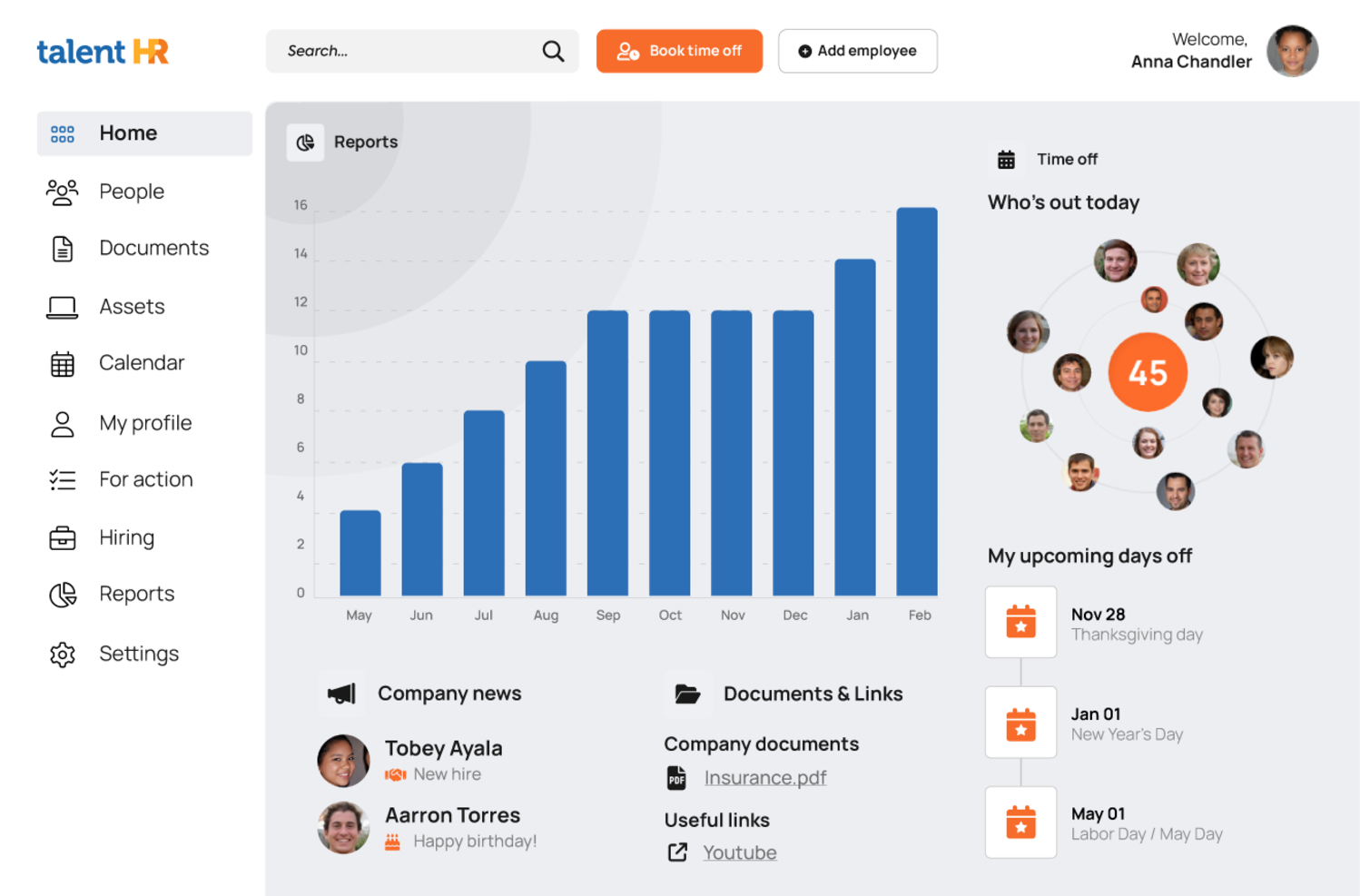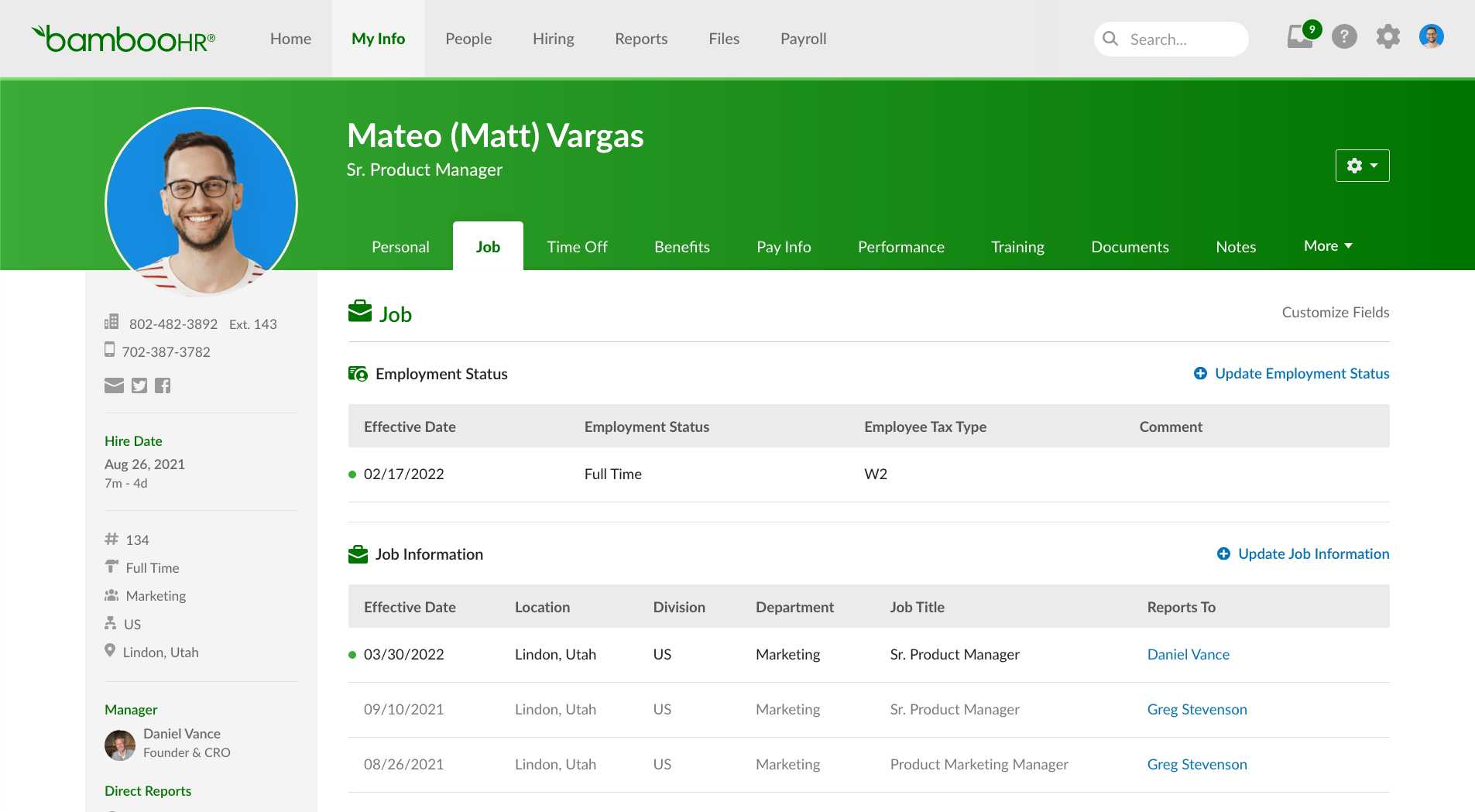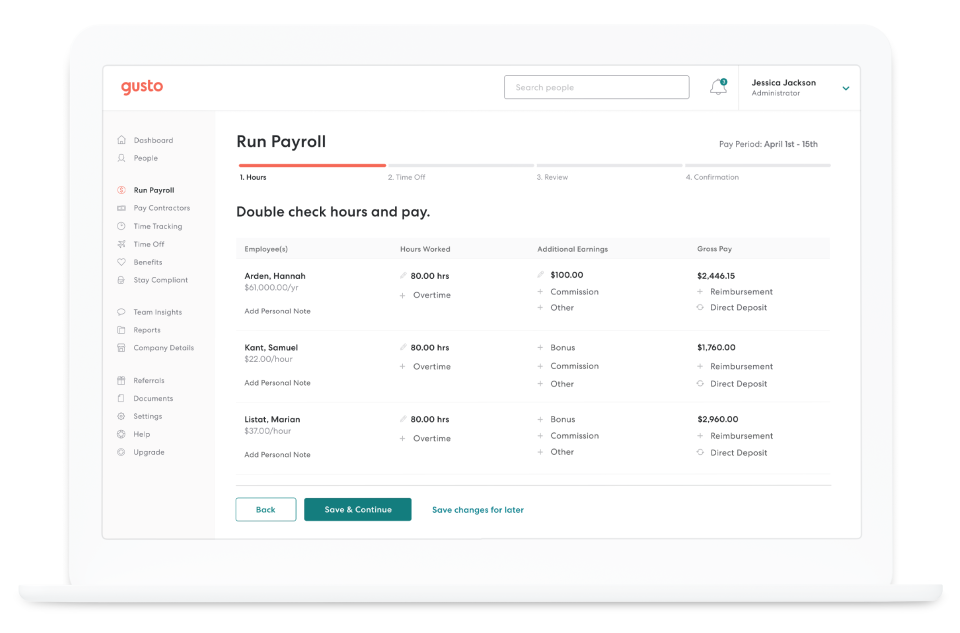
HR Management Systems for Startups: 3 Picks for 2025
Running a startup is a constant balancing act—hiring the right people, managing payroll, keeping track of time off, and somehow making sure nothing slips through the cracks at the same you focus on the business. In the early days, a few spreadsheets and shared calendars might do the trick, but as your team grows, so do the challenges. Suddenly, tracking leave requests in a .xlsx file isn’t so practical, and mistakes in payroll can bring about real headaches.
HR management systems have become a business-saver here. The right tool can automate repetitive tasks, keep organized profiles of each employee, and free up your time to focus on building and scaling your business—without hiring a giant team of HR professionals and maybe relying on some specialists or just the founding team. But with so many options out there, how do you choose the one that fits your startup’s needs? Let’s break it down.
What Is an HR Management System?
A Human Resource Management System (HRMS) is a software solution designed to handle core HR functions such as payroll, leave tracking, employee record management, and recruitment. These workforce management systems are designed to make administrative tasks easier and improve data accuracy and regulatory compliance while record-keeping. For startups, an HRMS can double as a centralized hub to manage HR data, automate repetitive processes (like sending out those onboarding emails!), and support decision-making.
Managing payroll manually can lead to miscalculations and compliance issues, but an HRMS automates salary processing, tax deductions, and direct deposits. It also simplifies leave tracking so that employees can request time off without endless email exchanges—while giving managers instant access to approve them. Keeping employee records, contracts, and performance history organized is another key benefit, as it makes sure important documents are always up-to-date and easy to find. Some systems even offer recruitment and onboarding tools so that startups can let an intern join in (and access a different set of benefits altogether) without getting buried in paperwork.
Without an HRMS, startups often rely on spreadsheets and scattered files, which inevitably become unmanageable as the team grows. Automating these processes definitely saves time, but it also helps maintain compliance with labor laws and payroll regulations. It also improves the employee experience—and, in turn, employee engagement—as it gives staff easy access to some decision-making tools (like requesting their own time off). More importantly, an HRMS helps startups scale with efficiency. What works for a five-person team won’t work for fifty, and having the right system in place from the start prevents growing pains down the line.
HR Checklist for Startups: 6 Must-Know Practices →
Key Features to Look for in HR Management Systems
Actually, not all talent management systems offer the same capabilities, and choosing the right one can make a big difference in how well your startup handles HR tasks. The best systems go past the basics of staff management and provide tools that simplify workflows, scale down repetitive chores, and support company growth—sometimes even via technologies that involve machine learning. Here are the key features to look for when evaluating HRMS systems:
Friendly Pricing
Not exactly a feature, not exactly a design choice, but nonetheless, a really essential part of a functional HR management system for startups. HRMS software should be priced so that startups can begin using it without paying for the core features. Ideally, these tools should have a starter plan that runs for free.
Leave and Attendance Tracking
Managing time off manually can lead to scheduling conflicts and miscommunications. Good HRMS software allows employees to request leave easily, while managers can approve requests and track absences in real-time. With built-in calendars and automated approvals, startups can keep schedules organized without endless email chains.
Recruitment and Onboarding Tools to Get the Best Talent
The ideal HR tool for startups allows founders to run job ads (on third-party sites or on their own Careers page), start prospecting the candidate, and eventually onboard them on the very same platform.
This sounds easier said than done! Hiring is a major challenge for growing startups, and an HRMS can simplify the process as it automates job postings, tracks applications, and manages onboarding tasks. Through digital offer letters and pre-boarding checklists, these applicant tracking and onboarding tools make sure startups can pull in the best talent in the market, and that new hires have everything they need from day one.
Automation on Benefits Administration and Help with Payroll
Payroll errors can be costly, and managing benefits manually can be confusing if you got several employee tiers, like part-time and full-time employees. An HRMS can safety store employee information such as their payment details. It also simplifies benefits administration. This way, you can easily manage employee health plans, reimbursements, and other perks without compliance headaches (and without accidentally offering an off-limits bonus to an intern!)
Differences Between Full-Time vs. Part-Time Jobs (and How Benefits Play Out) →
Customization for Company Size and Culture
Every startup operates differently, so an HRMS should be flexible enough to match your company’s structure and policies. A customizable system should guarantee the software grows with your business while you set up custom approval workflows, define performance review methods, or create personalized leave policies.
API and Integration with Other Tools
An HRMS should integrate with the tools your team already uses. Whether it’s Slack for communication, payroll software for getting those checks in time, or project management platforms, every HRMS software you consider should have integration capabilities and a well-documented API.
3 Best HR Management Systems for Startups in 2025
In this section, we’ll review some of the top HR management systems for startups in 2025. We’ll consider their features, benefits, and drawbacks to help you choose the best solution for your team.
TalentHR

TalentHR offers a reliable, all-in-one HR platform designed to meet the needs of small businesses and startups. With its free plan available for teams of up to 10, it ships with a checklist of essential HR features that make it a perfect fit for growing companies looking for an affordable, scalable solution.
Since it's a SaaS solution, startups can get it running with a few clicks. When the startup needs to scale it up, it's just a matter of continually adding employee records. Startups that make it big should not expect to migrate with TalentHR.
The free plan includes fundamental HR tools like HR management, time off tracking, document management, applicant tracking, employee onboarding, performance management, and reporting. These core features are included at no extra cost, which is ideal for small teams with limited budgets.
For startups looking to upgrade their processes, TalentHR offers several standout features. The mobile app makes sure you can manage HR tasks and access your entire workforce data from anywhere. Plus, with its customizable careers page, TalentHR allows you to create a branded page that showcases your company culture and attracts the best talent.
One of the platform’s most unique features is its AI-powered applicant tracking. TalentHR helps generate compelling job descriptions and automatically assesses candidates based on the specific skills needed for each role.
On top of this, it integrates conveniently with popular tools like Slack, Google Calendar, and Zapier, or you can use its well-documented API for greater customization. And regardless of what plan you choose, TalentHR offers free, unlimited email support, so that you're always covered when you need help.
While the free plan is excellent for small teams, larger startups may need to upgrade to access additional features or accommodate more users.
BambooHR

BambooHR is appreciated for offering a suite of HR tools that ease tasks such as onboarding, performance management, and employee data management. Many users find its interface intuitive, which makes it easy to access key HR information and track things like time off, PTO, and company announcements. The system’s customization options have received positive feedback, and HR professionals call it a good HRIS system.
Reviews of startup founders with BambooHR are more limited, because it's mostly used by HR reps. However, perhaps one of the main shortcomings is the setup process. While the platform is customizable, configuring it to fit a company’s specific needs appears to be time-consuming. Also, without a dedicated account manager, users often find themselves relying on the help portal or customer support for orientation, which can be less efficient for businesses without an in-house HR expert.
Another drawback seems to be the platform’s integration capabilities. BambooHR has an integration marketplace and offers integrations with popular tools like Google and Slack, but users have pointed out that some integrations can be moderately restricting. More advanced integrations may require technical adjustments, such as customizing API calls, which is likely be tough for smaller businesses without IT resources.
Pricing is another consideration. BambooHR does not have a free plan. While BambooHR’s core features are solid, many users report that additional costs for add-ons or customizations typically increase bills. Also, they require you to connect with them and ask for a quote to know how much they'll charge.
Gusto

Gusto is an HRMS that focuses on payroll, benefits, and compliance. Its primary strength is in payroll software. The system also includes other tools like employee onboarding and benefits administration.
Many users highlight its simplicity, especially when it comes to onboarding new employees. Features like automatic tax filing and state compliance are also frequently mentioned as valuable time-savers.
According to users, one of the recurring trouble spots is related to time management features, particularly for salaried employees. Some users have pointed out that Gusto’s time-tracking tool is mainly designed for hourly employees and lacks the necessary customization for salaried workers. Additionally, the time-off management feature is also limited. While some businesses provide employees with a full leave balance at the start of the year, allegedly, Gusto only allows employees to accrue leave over time. (Of course, this could be a user's complaint, and Gusto might have addressed it already).
Gusto starts at $40/month. But they start charging for arguably essential features right away. So companies using Gusto should expect to pay out more than forty dollars a month.
6 Small Business Employee Benefits You Should Consider →
How to Choose the Right HR Management System
Choosing the right HRMS isn’t a one-size-fits-all decision, so let’s break it down.
Comparing Company Needs
Start by thinking about your startup’s budget, how big your team is, and where you see it in the upcoming years. If you're a small team, look for something budget-friendly but scalable, so it can grow as you do. For a larger team or one that’s growing fast, you’ll want a system that can handle the increased workload and adapt to your changing needs. In any case, always opt for a SaaS.
Comparing Software Trials and Demos
Some platforms offer demos or free trials, so go over them and see how they feel in action. This hands-on approach helps you get a sense of how easy the software is to deal with and whether it’ll fit your needs. The ideal platform should have a free plan that lasts for as long as your startup requires it to be without charge, and also includes free trials for more advanced features.
Prioritizing User-Friendly Interfaces for Small Teams
For smaller teams, simplicity is fundamental. You don’t need complex systems with features you won’t use. Instead, look for an HRMS that’s easy to use with a clean, intuitive interface that won’t require a ton of training. And if you can get it set up in seconds, then that's a big plus.
Tips for Getting Started
Getting your HRMS up and running smoothly is important to avoid hiccups. Here are a few tips to help the process go off without a hitch:
How to Implement the Software Without Disrupting Operations
When you’re ready to get started, try to set up the HRMS during less busy times, like on the weekend or after hours. But the tool you chose might require you a few clicks to get started. So, this means you don't necessarily have to roll out features gradually.
Push for Team Adoption
You can't run training sessions if you're a startup. You're too busy working and making the business succeed. So make sure you picked out a friendly tool and simply push for adoption. If someone needs their time off and comes around by the watercooler to tell you their plan, remind them that the official channel is the tool. That's how it works.
Final Thoughts: Investing in the Right HR Solution for Your Startup
An HR solution is a suitable alternative for startups who can't commit financially to sign up a huge HR team, or who have a very specialized team that calls for some support to get the best talent out there. With the right HRMS, you can automate routine tasks like payroll, leave tracking, and employee management.
When choosing the ideal HR solution, consider factors like the size of your team, your budget, and your short-term goals (You need to run job ads? You need to administer benefits or perks?). TalentHR is a great choice for many startups, especially with its free plan for smaller teams and features that can upgrade as your company does. BambooHR, Gusto, and others also offer interesting solutions depending on your priorities (and your wallet).
Try to test their features with demos or trials, and decide on one that fits best with your startup’s workflow. But, with all the information laid out for you, maybe set out to stick to a single solution instead of trying plenty of them. In the end, you don't have time to start migrating on and off from numerous solutions. If you set up the right HRMS now, you can avoid growing pains down the road and make sure that as your team expands, your HR processes stay streamlined and manageable.
Sign up for free to TalentHR today and try all the features with the Premium plan 14-day trial. You can return to the free version right afterward—no questions asked. And no credit card needed.


